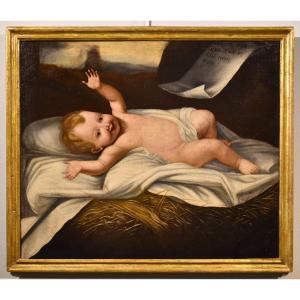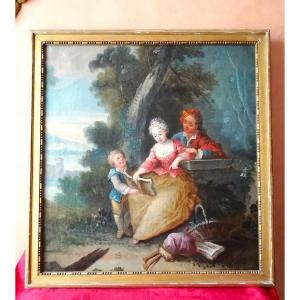Flemish painter active in Veneto in the early 17th century
Oil painting on canvas
Cm. 62 x 74
With antique carved and lacquered frame cm. 82 x 95
Details of this work: https://www.antichitacastelbarco.it/it/prodotto/pittore-veneto-fiammingo-del-xvii-secolo
We are witnessing a sumptuous banquet, set in a sumptuous setting of a building with imposing architecture, where a young boy is cheering with the company of some dissolute women who try to seduce him, while he lets himself be carried away by the pleasures of life, between servants and musicians.
It is a very interesting scene, which illustrates the pleasures of the prodigal son, while he is senselessly squandering the part of the inheritance that he has demanded in advance from his father. We note the subtlety with which the author represents prostitutes, with the elderly woman who seems to tell them how to act, and the confidential, but modest, attitude of the young man.
The dissolute life described in the parable of the prodigal son is an imaginative prologue of sins with respect to the Gospel episode in which the grace of paternal forgiveness is represented. The episode, which is well known, has as its protagonists an elderly man and two children: one virtuous, who contributes to the growth of family property, the other wasteful - prodigal, in fact - who, away from home, will squander all the money until the ruin. When the latter, with no more resources, is forced to return to his native village, he will be welcomed by his father with immense happiness and love, ready to welcome his sinful son.
Very frequent in painting between the sixteenth and seventeenth centuries, and especially in the Flemish context, were the paintings that licentiously imagined the life of the dissolute young man and that, while taking pretext from the biblical world, often entered into the sensual details, so that the resulting paintings appear as a celebration to the lust of the young man before being forced to repent.
The painting in question is characterized by its high quality and intense expressive power, which is revealed in the detailed rendering of the individual protagonists, represented with precise attention to detail, of the faces in particular. In these unequivocal aspects are the Flemish stylistic elements, mitigated by a decisive typically Venetian influence, in the drapery and in the definition of the figures. In this regard, it should be remembered that between the sixteenth and seventeenth centuries Venice hosted numerous Nordic painters, both independent and disciples of large pictorial workshops.
In detail, by carefully observing the details and the 'eclectic' style of the composition, due to its worldly verve, we are inclined to bring the painting closer to the Venetian-Dutch style of Paolo Fiammingo (Antwerp about 1540 - Venice 1596) who in the seventeenth century it was certainly the object of study and inspiration for many painters active in the lagoon city.
In his figures, his ways adhere to those of the greatest Venetians, in particular Tintoretto and Palma the Younger. The main scene betrays the knowledge of our Flemish author both of the models of Veronese and, especially in the architectural structure with columns and in the red drapery that crown the scene, of Titian and the Bassano workshop.
The work is presented in a very good state of conservation, completed by a magnificent frame in carved and lacquered wood.
Complete painting with certificate of authenticity in accordance with the law.
For any information, do not hesitate to contact us.






























 Le Magazine de PROANTIC
Le Magazine de PROANTIC TRÉSORS Magazine
TRÉSORS Magazine Rivista Artiquariato
Rivista Artiquariato
